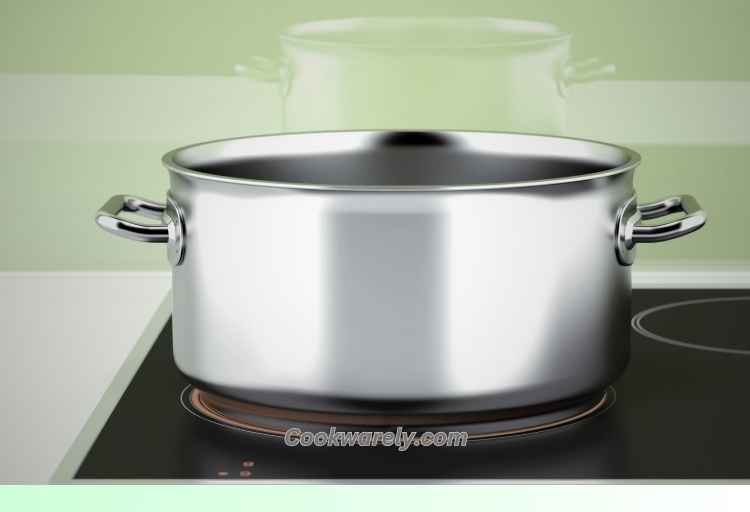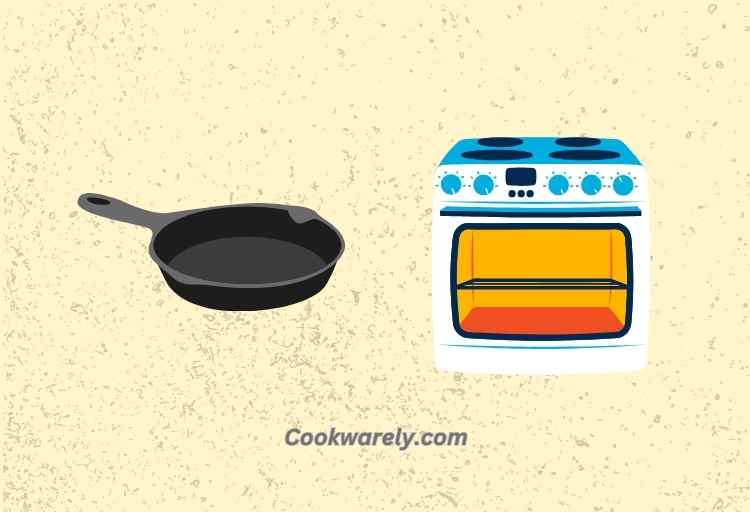How To Tell If Cookware Is Induction Ready? 6 Aspects!
Induction ready cookware should have a flat and smooth bottom. Irregularities or dimples can affect the efficiency of heat transfer, so a flat base is essential for cooking.
To check if your pots and pans work with induction stoves, use a magnet. If the magnet sticks to the bottom and the cookware is flat and made of iron or something similar, it’s good for induction.
To check whether your cookware is induction compatible:
First, place a magnet on the cookware’s bottom. If it sticks, it likely contains enough iron to work with induction.
Then, check that the cookware has a flat, smooth base. This ensures even heat distribution.
Also, consult the manufacturer’s instructions for specific compatibility details.
Finally, place the cookware on an induction hob within the designated zone and ensure it heats up efficiently.
6 Aspects to Consider If Cookware Is Induction Ready
| Aspect to Consider | How To Know |
|---|---|
| Magnet Test | Place a magnet on the cookware’s bottom. If it sticks, it’s induction-compatible. |
| Flat, Iron-Based Base | Check that the cookware has a flat base made of iron or iron-based materials. |
| Manufacturer Guidelines | Read the manufacturer’s instructions or guidelines for induction compatibility. |
| Testing with Induction Hob | Turn on the induction hob, identify induction zones, and place the cookware within the markings. |
| Even Heating | Ensure the pan is filled and properly placed within the induction zone for even heating. |
| Safety Precautions | Follow recommended safety precautions to prevent splashing and accidents. |
Key Takeaways
- Ensure that the cookware you use is indeed induction-ready. Look for the induction symbol or consult the manufacturer’s guidelines to confirm compatibility.
- When cooking on an induction cooktop, distribute the heat evenly by ensuring the cookware covers the entire induction zone. This helps prevent uneven cooking and hotspots.
- To protect both your cookware and the induction surface, avoid dragging pots and pans across the glass surface. Lift them gently when moving to prevent scratching or damage.

Five Facts About Induction Ready Cookware
- The magnet test is a highly reliable method to determine induction compatibility. If a magnet sticks to the bottom of the cookware, it indicates the presence of iron or iron-based materials, essential for induction cooking.
- Induction-ready cookware must have a flat and smooth base. This is crucial for efficient heat transfer and even cooking results. Dimples or uneven surfaces can hinder performance.
- Manufacturers provide specific guidelines and instructions for each cookware set. It’s essential to read and follow these guidelines to ensure safe and effective usage on induction cooktops.
- Many types of cookware, including stainless steel, cast iron, and some types of non-stick pans, can be induction-ready. It’s not limited to a single material.
- Careful handling is essential to prevent damage. Dragging cookware on the induction surface or using excessive heat can lead to scratches, warping, or other issues that affect performance and longevity.
How To Tell If Cookware Is Induction Ready?
Here’s a step-by-step guide on how to tell if cookware is induction ready:
1. Magnet Test
One of the simplest ways to check if your cookware is suitable for induction cooking is the Magnet Test. Here’s how to do it:
- Gather a Magnet: Start by grabbing a common refrigerator magnet. It doesn’t need to be a powerful one; any will do.
- Inspect the Cookware: Examine the bottom of your cookware. Look for any visible signs of iron or iron-based materials in the construction. Induction cooking relies on magnetic fields, so the presence of iron is crucial.
- Place the Magnet: Place the magnet against the bottom of the cookware. Make sure it makes good contact with the surface.
- Check for Attraction: If the magnet sticks firmly to the cookware’s bottom, it’s a strong indicator that your cookware is induction-ready. The magnet adheres because of the iron content, and this cookware should work efficiently on induction hobs.
2. Flat, Iron-Based Base
Another important factor to consider is the Base of the Cookware:
- Look for a Flat Base: Induction-compatible cookware should have a completely flat and smooth bottom. This is crucial for even heat distribution. Any dimples, warping, or irregularities on the base can hinder the effectiveness of induction cooking.
- Check for Iron Content: As mentioned earlier, the cookware must contain iron or iron-based materials. This is what allows the magnetic field to interact with the cookware and generate heat.
3. Manufacturer Guidelines
Always consider the Manufacturer’s Guidelines:
- Read the Instructions: Consult the manufacturer’s instructions or guidelines that came with your cookware. These documents often contain specific information about the cookware’s compatibility with induction cooktops.
- Follow Manufacturer Recommendations: Manufacturers may provide additional details on how to use their cookware with induction hobs. They might offer insights into the ideal settings and precautions.
4. Testing with Induction Hob
To perform a practical test with your induction hob:
- Identify Induction Zones: Turn on your induction hob and find the Induction Zones marked on the glass surface. These are the areas where induction cooking will work.
- Activate the Zone: Using the control panel, activate the specific induction zone you want to use.
- Proper Placement: Place your cookware inside the markings for the selected zone. Ensure that it’s positioned correctly and that it’s filled with ingredients before heating begins.
- Observe for Correct Functionality: If the cookware is induction ready, it should heat up efficiently within the designated zone. It’s essential to follow these steps precisely to ensure the best cooking experience.
5. Safety Precautions
Always take safety precautions:
- Even Heating: Properly positioning your cookware within the induction zone ensures even heating. This helps prevent hotspots and ensures that your food cooks consistently.
- Avoid Overhang: Avoid placing too much of the cookware outside the zone’s markings. If you do, the heating level indicator may flash, indicating improper placement.
What makes cookware induction ready?
Induction cookware is a special type of cookware designed for use on induction cooktops.
The name implies that it does not contain any metal, but it is important to select the right type. A non-induction-ready pan may wear or warp when used on an electric or gas stove.
Induction-ready cookware is typically made of cast iron or non-magnetic stainless steel.
Cookware made from aluminum is not induction-ready, but it will work on a conventional stove. It is important to choose induction-ready cookware that has a flat bottom.
Induction cooking provides fast and even heating, with virtually no stirring or flipping required. It also results in complete moisture vaporization, making the food taste better.
Additionally, it is convenient for large households as it eliminates the risk of a pan burning on the element.
How To Test Pots and Pans for Induction Cooking?
When choosing pots and pans for induction cooking, it is essential to ensure they are compatible with your stove.
Using a magnet and a pan, you can conduct an induction compatibility test at home. If the magnet sticks to the pan’s bottom, the pan is induction compatible.
Stainless steel and aluminum are both magnetic. The magnetism of the steel will vary depending on its composition. Induction-compatible stainless steel will have no problem with these metals.
However, it is still a good idea to test a pot or pan first, as stainless steel can be prone to heat damage.
A good way to determine if your pots and pans will work on induction is to fill the pan with water and place it on the induction cooktop. The cooking surface should begin to heat, and the pan should start to boil.
Will induction cookware work on induction cooktop?
When it comes to induction cooktops, you have a few different options. Some cookware is specially made to use magnetic fields, while others use heat-transfer fluids.
While there are some differences between the two, you can use the same pan on both types of cooktops.
In order to test if your current cookware is induction compatible, you should hold a magnet near the bottom surface of the pan.
If the magnet sticks to the pan, it means it is magnetic. This means that your induction cookware will work on the stovetop.
Induction-compatible cookware includes cast iron and steel. Stainless steel must also contain some iron, or have a magnetic layer. Many enameled cast iron cookware is also compatible.
Some stainless steel products may work on induction cooktops, but you should check the label of your cookware.
A good example of induction-compatible cookware is the MC2 line by All-Clad, which uses stainless steel and aluminum.
Conclusion
To sum it up, figuring out if your cookware works on an induction stove is simple. Just use a magnet, check for a flat bottom, and follow what the manufacturer says. These steps ensure your cookware is good to go for induction cooking.





